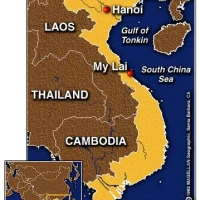The first time I heard this story, it was several years ago on a television documentary. I was blown away by the idea of such a disaster. On May 31, 1889, the South Fork Dam collaped causing a flood in Johnstown,Pennsylvania, that kills more than 2,200 people.
Johnstown is 60 miles east of Pittsburgh in a valley near the Allegheny, Little Conemaugh, and Stony Creek Rivers. It is located on a floodplain that has been subject to frequent disasters.
Because of the area’s susceptibility to floods, a dam was built in 1840 on the Little Conemaugh River, 14 miles upstream from Johnstown. Nine hundred feet by 72 feet, it was the largest earth dam (made of dirt and rock, rather than steel and concrete) in the United States and it created the largest man-made lake of the time, Lake Conemaugh. The dam was part of an extensive canal system that became obsolete as the railroads replaced the canal as a means of transporting goods. As the canal system fell into disuse, maintenance on the dam was neglected. This is a little different background then how it had been portrayed in the documentary I saw years ago. In the program, it was people with money that created a resort colony club around the lake created from the dam. When these people didn’t maintain their private dam, thousands of people lost their lives.
In 1889, Johnstown was home to 30,000 people, many of whom worked in the steel industry.
On May 31, the residents were unaware of the danger that steady rain over the course of the previous day had caused. A spillway at the dam became clogged with debris that could not be dislodged. An engineer at the dam saw warning signs of an impending disaster and rode a horse to the village of South Fork to warn the residents. However, the telegraph lines were down and the warning did not reach Johnstown. At 3:10 p.m., the dam collapsed, causing a roar that could be heard for miles. All of the water from Lake Conemaugh rushed forward at 40 miles per hour, sweeping away everything in its path.
The following is a physics-based simulation of the 1889 Johnstown Pennsylvania dam break and flood. Timing, water volumes, flood depths and flow speeds are physical aspects of the simulation that can be compared with historical reports of the day’s events.
People in the path of the rushing flood waters were often crushed as their homes and other structures were swept away. Thirty-three train engines were pulled into the raging waters, creating more hazards. Some people in Johnstown were able to make it to the top floors of the few tall buildings in town. However, whirlpools brought down many of these taller buildings. A bridge downstream from the town caught much of the debris and then proceeded to catch fire. Some people who had survived by floating on top of debris were burned to death in the fire. Reportedly, one baby survived on the floor of a house as it floated 75 miles from Johnstown.
This small excerpt of the Academy Award Winning short film, the Johnstown Flood shows just how devastating it was. The Johnstown Flood is the story of one of the most devastating disasters in American history. The film chronicles the events leading up to and following the moment on May 31, 1889 when a private dam burst, unleashing 200 million tons of water into the city of Johnstown, Pennsylvania. An extended version of The Johnstown Flood was aired on the PBS series “American Experience,” using never before seen images of the South Fork Fishing and Hunting Club.
One of the American Red Cross’s first major relief efforts took place in the aftermath of the Johnstown flood. Clara Barton arrived five days later to lead the relief.
The following photographs are just unbelievable.

Debris from the Johnstown Flood piled up against the Pennsylvania Railroad’s Stone Bridge and caught fire
It took five years to rebuild Johnstown, which again endured deadly floods in 1936 and 1977.
The World’s Most Deadliest Floods
You may also be interested in my series of posts on Hurricane Katrina:
What Happened August 23rd through September 2nd – Remembering Katrina (Part 1)
What Happened August 23rd through September 2nd – Remembering Katrina (Part 2)









 Check out my other blog
Check out my other blog I'M PUBLISHED
I'M PUBLISHED I'm Published Again
I'm Published Again









I think man should stop trying to mess with Mother Earth. She will bite back.
LikeLike
I agree. A few years ago in a town near I live, there was a lake community with a private lake and dam. The dams failed in heavy rains and a town down stream suffered severe damage. The private owners didn’t maintain the dams and in the end, no one was ever charged for the crime.
LikeLike
Hmmm-Why would they build right there when there is always a threat of a major flood-I don’t get it
LikeLike
I think it was just as the documentary I saw had it. The wealthy families wanted their lake front colony club and the dam created those lakes. Afterall, they were not the families that would be deal with the results of a stupid idea as they were absentee (these were vacation areas for them) and high above anyway.
LikeLike